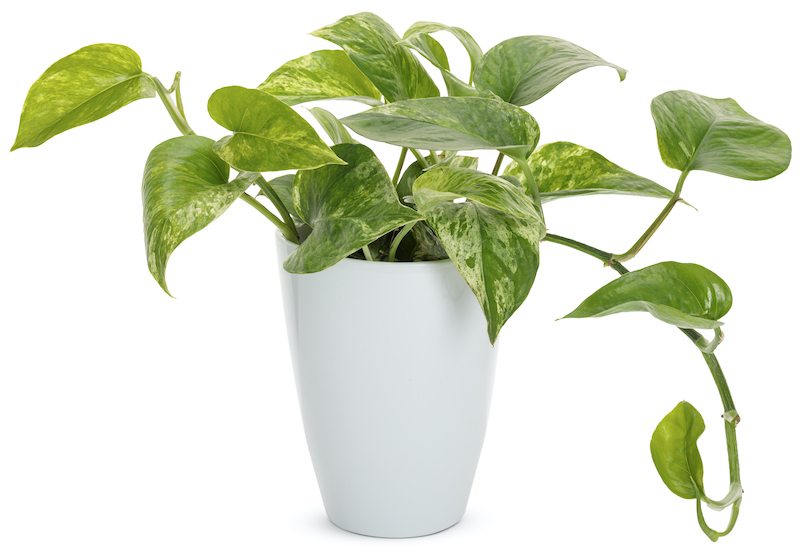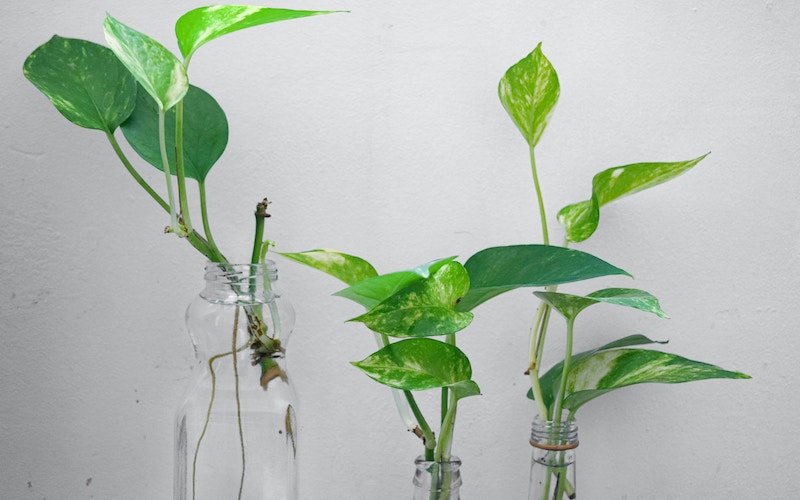Growing Pothos
Pothos is possibly the easiest houseplant to grow. Trailing vines feature leaves that come to a point and can be solid green or have yellow, light green, white, or cream variegation. Pothos originate from the South Pacific, and these plants are very forgiving in terms of care. This laid-back plant is a good choice for new plant owners, but experienced growers love Pothos for its lush vines. Pothos is a fast-growing plant that, with proper care, can add inches of beautiful foliage each month during the growing season.

Pothos Sunlight Requirements
Pothos is an adaptable houseplant that can live in various light levels. Expect the best results and fastest growth when Pothos receives bright indirect light. Pothos can grow in medium and low indirect light, but it will take longer to push out new leaves. Variegated varieties may lose their color and intensity when grown in low light. Direct sunlight can damage the leaves and may cause brown, sunburn marks and dead or stunted growth.
Planting Pothos
Rich soil that is moist but well drained keeps Pothos happy and healthy. The soil should promote drainage because while this plant can handle some neglect and varying conditions, soggy soil is a no-go. Pothos can handle tight conditions but repot when it becomes root-bound and you see roots emerging from the holes in the pot. Repot Pothos in the spring when the plant is actively growing.

Watering Pothos
Pothos plants prefer average humidity. Let the soil dry out before watering Pothos plants. Feel the soil to gauge the dryness and water when necessary. The leaves may form black spots or go limp when the roots are too wet for an extended time. Drooping or curling leaves and brown edges indicate the plant is too dry. The plant is already under stress when leaves turn color, droop, or drop, so feel the soil to water when the plant needs a drink.
Fertilizing Pothos
Pothos plants are fast growers, but they are not heavy feeders. Light applications of fertilizer can give them a boost and help the plants continue to push out new foliage. Feed Pothos plants using a balanced, water-soluble plant food. Fertilizer can be applied twice monthly during the spring and summer when the plant is actively growing. Do not feed Pothos plants when they are dormant during the fall and winter.
Common Pothos Problems
Pothos plants do not normally have a lot of problems, which makes sense given this plant's easy-care reputation. Pothos can be affected by mealybugs, so inspect the plant for signs of infestation to catch the problem early. Clean infested plants with horticultural oil or insecticidal soap to take care of the pests.
Propagating Pothos
Expand your Pothos collection by taking cuttings to start new plants. Trim a stem section with a couple of leaves and growth nodes or aerial roots. Place the cut end of the stem in water or moist soil. Cuttings propagated in water will form roots after a few weeks and can be moved to soil when the roots are a couple of inches long. Soil-propagated cuttings must be kept damp for several weeks until the plant forms roots.

Growing Pothos Outdoors
Dress up a porch or outdoor space and give your Pothos a summer vacation by relocating the plant outdoors. Warm sunny weather will support new growth while adding greenery to your space. Bring your Pothos plants outside when the temperature is consistently over 50 degrees F. Water when the top few inches of soil are dry, but be prepared to water more often in dry climates or during a drought. Use a container with drainage, so rainwater will run through and not collect in the bottom, which can cause root rot.
 |
Author Alison Cotsonas - Published 3-06-2023 |
